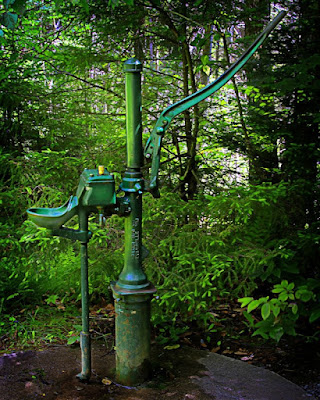 In Wednesday's post, the image was a garish, over the top, HDR shot. I said it came from just playing around to see how far that particular image could be taken. I'm back to reality and today's image was taken within a half hour and a half mile of the stream in Wednesday's image. This shot is also an HDR image. The big deal is the fact that it was taken in an entirely different way and finished as far to the right as Wednesday's image was to the left. Wednesday's image was very deliberately setup. Camera on the tripod, live view turned on, aperture set high to slow down the shutter speed and a remote trigger used to trip the shutter five times. Today's image is five shots, set one EV apart (-2, -1, 0, +1, +2), aperture set to about 5.6 to maximize shutter speed and hand held. To find out more, hit the "read more".
In Wednesday's post, the image was a garish, over the top, HDR shot. I said it came from just playing around to see how far that particular image could be taken. I'm back to reality and today's image was taken within a half hour and a half mile of the stream in Wednesday's image. This shot is also an HDR image. The big deal is the fact that it was taken in an entirely different way and finished as far to the right as Wednesday's image was to the left. Wednesday's image was very deliberately setup. Camera on the tripod, live view turned on, aperture set high to slow down the shutter speed and a remote trigger used to trip the shutter five times. Today's image is five shots, set one EV apart (-2, -1, 0, +1, +2), aperture set to about 5.6 to maximize shutter speed and hand held. To find out more, hit the "read more". The way my camera (Nikon D300) is set up I only have to tap the function button, found between the right hand grip and the lens mount, and spin the command dial to adjust the number of exposure EV steps I want to take. The difference for each step is set in the menu system. The camera was set to high speed continuous shooting and the fact that I had the bracketing set to five shots automatically stopped the shooting at five. A good stance, proper camera holding technique and breath control allowed the five shots to rattle off without any significant camera movement. I "chimped" while the buffer was sending each shot to the memory card and, when I didn't see any discernible bouncing of the water pump I thought I might have something I could play with.
.
Wednesday's image was put together in HRDsoft's Photomatix. Today's was done completely in Adobe's Photoshop, soup to nuts. Before someone goes crazy and yells about the trees on the edges not having enough detail, let me explain. A vignette was applied to the semi-finished image (as far as I'm concerned, no image is "finished" until a vignette has been applied) to hold the viewer and focus attention on the water pump. Therefore, the dark edges were an "artistic" decision, not some problem doing HDR in PS. Once the image was assembled, my "normal" workflow was used to bring out the richness of the image. After a start point was established the "real" work began.
.
The burning and dodging tools in Adobe Photoshop CS4 are a vast improvement over those found in past iterations of the program. Both are very usable if used with a light hand. In order to guide the viewer through the image some parts were brightened and some toned down. The overall effect is to make the pump pop out of the background. Just as an example, the far end of the pump handle was somewhat lost in the darkness created by the vignette and the trees. A little dodging, using a low exposure in the "shadows" range, was used on the end of the handle to slowly bring the handle forward.
.
Wednesday's goofing around was fun, but the straight use of HDR looks like it has a place in the photographer's toolbox. I understand I'm a little late to the game and some HDR zealots will say "Duh", but, better late than never.





0 comments:
Post a Comment